How To Covert A Table Fan Into A Wind Generator
The Table Fan Generator
How to make a Windmill out of an old Table Fan

This page will guide you through the steps needed in order to convert an ordinary table fan into a windmill generator. It is actually very easy to make a windmill out of a standard table fan.
The only tools you will need is a screw driver, wire cutters, a drill or bench press, drill bits, some magnets and super glue.
The home made windmill assembled in this project actually puts out 24 volts AC at a couple hundred milliamps. Cheap ceramic magnets were used in this project. For best results, use high power magnets to get much more energy output. You can connect this generator's output through a diode bridge rectifier to a 12 volt lead acid battery and charge it with no problem.
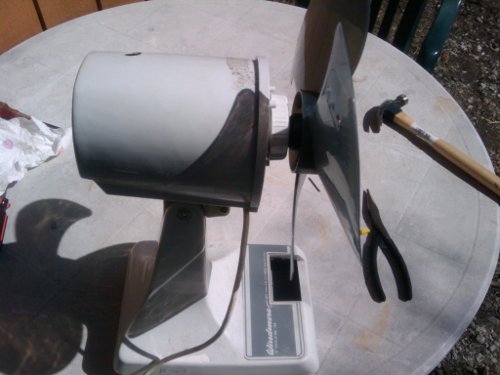
Find yourself an old, discarded table fan for this project. You can also go out and buy a new one, if you want. I just happened to have one laying around. The bushings were going out, so the fan made horrible squeeling noises when it ran. It was otherwise in perfect working order.
A little bit of cleaning and some lubricating oil had this fan spinning perfectly well again in no time.
Follow the pictures below for details as we go on. First, disassemble the fan casing and set all the parts aside. This is simple and normally only requires a screwdriver. Next, you will need to get a pair of pliers to remove the retaining pin on the armature shaft. Now you can remove the screws holding the fan casing together. Carefully open the fan casing, taking extra care not to break any of the very fine wires inside the fan motor.
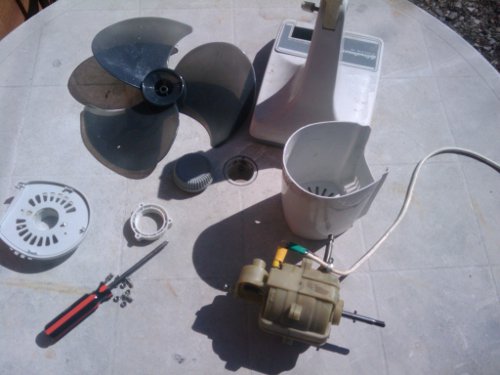



Locate the condensor. It is a little tube shaped thing, normally buried under some tape. Carefully remove this by simply cutting it out (not shown in photos). Carefully open the motor housing and remove the armature from the motor (below left).
Drill out four holes, evenly spaced around the armature. Make the holes the same size as your magnets, so they will snugly fit into the holes. Drill just deep enough to fit the magnets flush with the outside edge of the armature. You will probably need to sand off the edges just a little bit on two sides. See the pictures on the middle and right below for a finished armature. Notice the magnets evenly spaced around the armature. Put the armature back into the motor housing and give it a spin by hand to make sure the magnets do not rub or scrape inside the motor. If so, sand the edges a bit until they fit well.
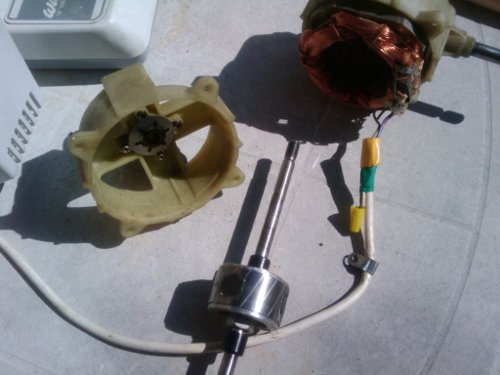


Now you can put the whole motor back together. Leave the condensor out. This will not be needed. You can mount the motor back on the original table fan base, or as in the photo below, mount it on a shaft outside. Paint all the parts before you leave them outside for any length of time. You will also want to seal all open holes and cracks with silicone to make it water proof and long lasting.

Cut off the electric switches and speed controls. Expose all the wire ends so you can test for the most power output. Put the fan in a strong wind and measure all possible combinations of wires to find the most voltage output. The motor coil has various wire taps, which allowed it to have a variable speed as a fan. You want to find the two outside ends of the motor coils. Depending on your use for the windmill, this may have an advantage. The home made generator has multiple taps on the coil, giving you multiple voltage outputs. You may charge a 12 volt battery, a 6 volt battery, or even rechargeable flash light batteries by using the various voltage outputs of you new generator. (See photo below).

Below you see the home made windmill in action charging batteries. The fist photo shows a small piece of scrap wood added as a tail fin to keep the windmill pointed into the wind. The second picture shows the windmill charging small AA batteries. A bridge rectifier and a couple filter capacitors were used to convert the voltage to DC and smooth out the output. As previously mentioned, there are various voltage outputs and in this case, the lowest voltage was used to charge up our flash light batteries. The last two photos show a converted box fan windmill outside charging 12 volt lead acid batteries.
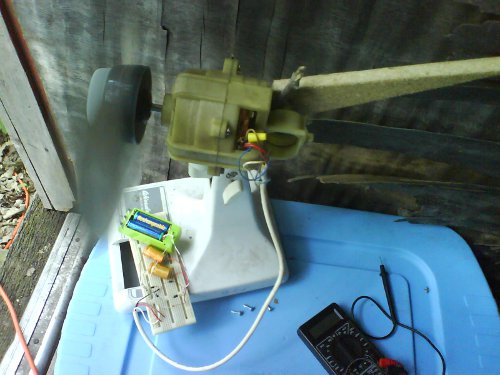
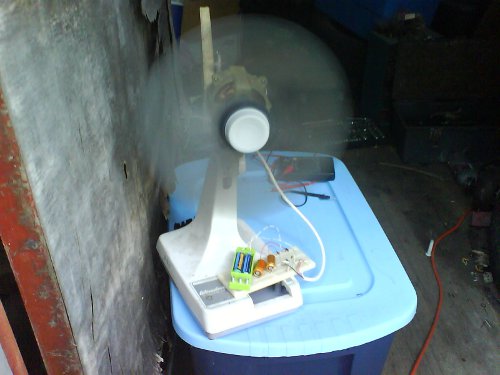

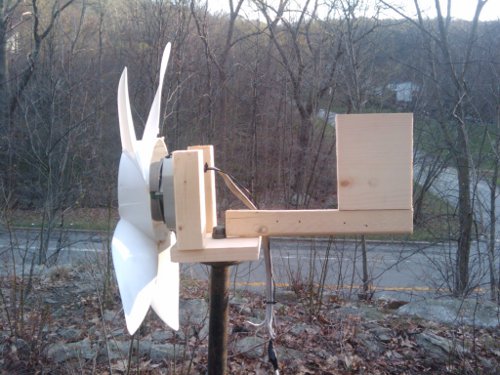
Final Notes:
You can use various fans for this project. There are also DC, battery operated fans on the market. This type of fan actually needs no converting at all. Simply place your table fan in a full wind and measure the DC voltage output. Put rechargeable batteries in your fan and put it outside in the wind to charge the batteries. Bring it inside when you need it and use it as a normal fan. Sort of like capturing the wind for later use.
You can also convert a box fan for even more power. Ever see a box fan left in a strong breeze? They really spin up fast. In the future we will convert a box fan into a generator and see what kind of results can be achieved.
Disclaimer: The ideas presented here are for informational purposes only. Experiment at your own risk. We assume no responsibility whatsoever.
Feel free to ask any questions or get help with your project on our
About the Author
| Troy Reid |




